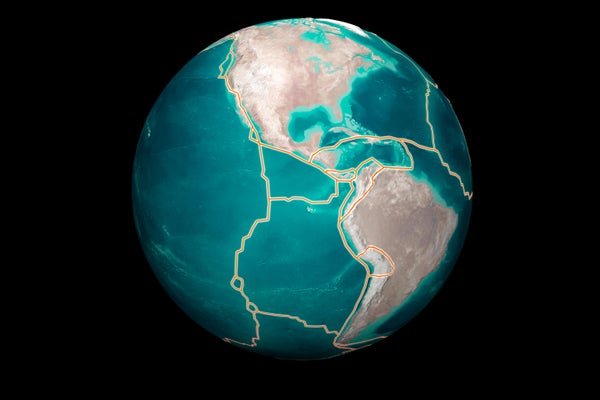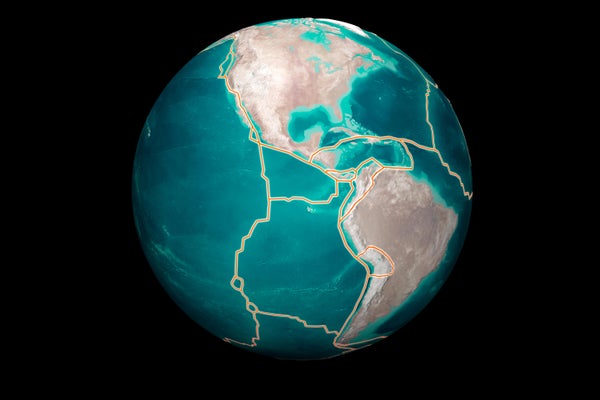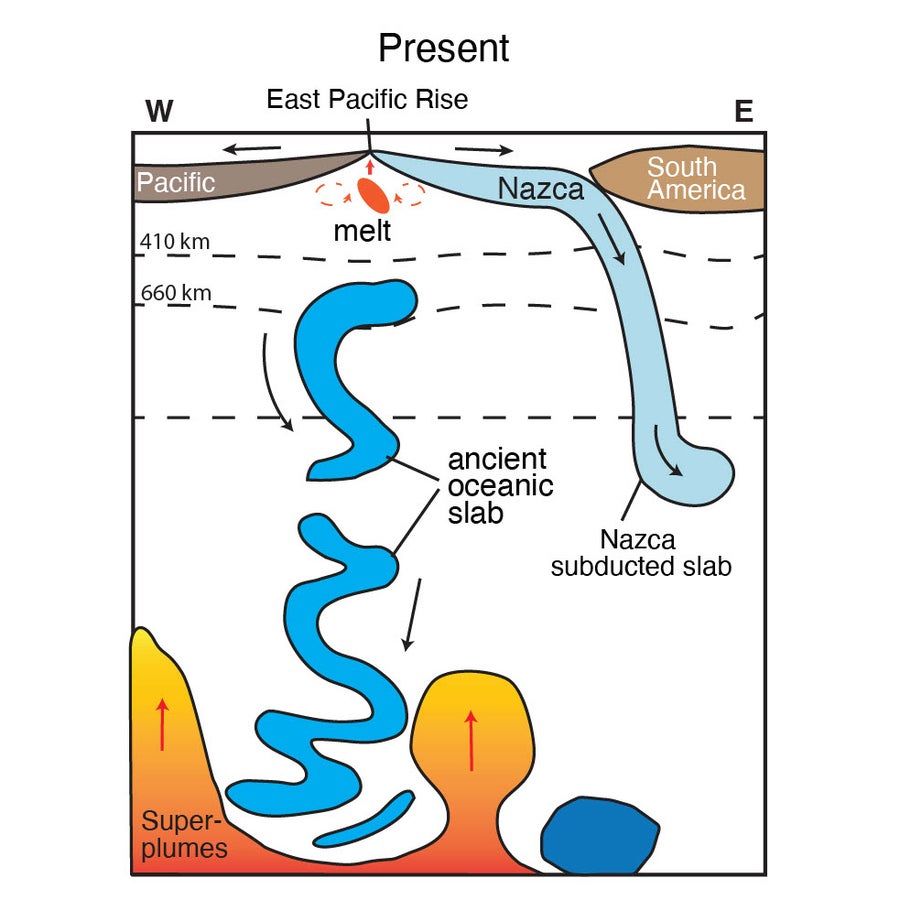
October 17, 2024
3 min read
Ancient Seafloor Discovered Slowly Sinking into Earth’s Mantle
A vast, ancient slab of seafloor plunged beneath the Pacific Ocean and has hovered in Earth’s mantle for more than 120 million years, a new study suggests

The Nazca plate is located to the west of South America’s Pacific coast. On the western edge of the Nazca plate is the East Pacific Rise, while the Nazca subduction zone runs along the eastern edge.
Naeblys/Alamy Stock Photo
An ancient slab of seafloor that was around when Earth’s earliest known dinosaurs emerged, has been discovered beneath the Pacific Ocean, where it has seemingly hovered in a sort of mid-dive for more than 120 million years.
In addition to illuminating geological processes deep inside Earth, the cold, descending slab of dense rock, located some 410 to 660 kilometers below the planet’s surface, could explain a mysterious gap between two sections of a giant blob in the mantle layer.
“This study provides a first present-day example of how a cold downwelling from above is breaking up a deep mantle blob,” says Sanne Cottaar, a professor of global seismology at the University of Cambridge, who wasn’t involved in the discovery. The paper was published online on September 27 in Science Advances.
On supporting science journalism
If you’re enjoying this article, consider supporting our award-winning journalism by subscribing. By purchasing a subscription you are helping to ensure the future of impactful stories about the discoveries and ideas shaping our world today.
Deep beneath our planet, two gargantuan, continent-size blobs of sizzling material rise from Earth’s hot, liquid outer core into its rock-filled mantle layer. Scientists can’t directly see these megastructures, which are hundreds of kilometers tall and thousands of kilometers wide. Instead researchers infer their existence from imaging techniques that rely on the way seismic waves travel through them. Within the blobs, seismic waves slow down, leading to their more technical name, large low-shear-velocity provinces (LLSVPs). The larger and better understood LLSVP, called the African blob, sits beneath the East African Rift Valley, which runs from the Red Sea to Mozambique. There two tectonic plates are slowly moving apart and may eventually split the continent.
“At the East African rift zone, we have a present-day example of how a large hot upwelling mantle plume that originates at these deep mantle blobs (so aptly named LLSVP) starts to break up a continent,” Cottaar says.
Scientists aren’t sure exactly how these LLSVPs formed (some research suggests they are relics of the collision that created our moon), what they are made of or how they contribute to surface events such as volcanism. “The general idea is that mantle blobs are likely pushed around by subducted slabs. The two main blobs are surrounded by ‘graveyards’ of subducted slabs,” Cottaar says, referring to the edges of oceanic plates that have descended below, or subducted, another plate.
Jingchuan Wang, a geologist at the University of Maryland, College Park, and his colleagues were interested in examining the mantle blob under the Nazca plate in the Pacific Ocean, off the coast of South America. Past research had suggested a structural anomaly exists there that seems to split the blob in half. In the new analysis, which involved measurements of properties of earthquake waves traveling deep underground, the researchers saw evidence for something cold and dense stuck in that mantle blob gap.
“The most parsimonious explanation for the cold temperature and high seismic velocity is the presence of a subducted slab,” Wang says. “However, this area has no active subduction, and the imaged slab has already detached from the surface. Therefore, we believe we are observing an ancient slab.”

This illustrative diagram shows the ancient subducted “slab” the team imaged. This ancient seafloor slab has a direct impact on the large-scale structure called a mantle blob.
The team describes two possible scenarios for how this ancient seafloor ended up wedged in the middle of the Pacific mantle blob. In one, a broken-off edge of ancient seafloor fell between the predecessor of the Nazca plate and the part of the ancient supercontinent Gondwana that became South America some 250 million years ago. That broken plate part, which functioned as the seafloor during the early Mesozoic era, would have subducted under those two plates, whose boundary now forms the fastest widening oceanic ridge in the world, called the East Pacific Rise.
Alternately, the descending slab might have dipped beneath the Nazca plate’s predecessor, Wang says, in a bout of ancient tectonic reshuffling.
Regardless of how it got there, part of that seafloor is very slowly creeping downward at a pace of about 0.5 to one centimeters per year—nearly half the rate at which a similar object would sink if it were lodged just below this zone in the mantle.
The thickness of the slab and the viscosity (or gumminess) of this region of the mantle, Wang says, could explain the slow sinking speed.
“Our findings help link the plate tectonic history of the past 250 million years to present-day mantle structures,” Wang says, “providing clues about Earth’s complex past, in particular what was happening in the subsurface, which often leaves no discernible geological fingerprints on the surface.”
Source link



